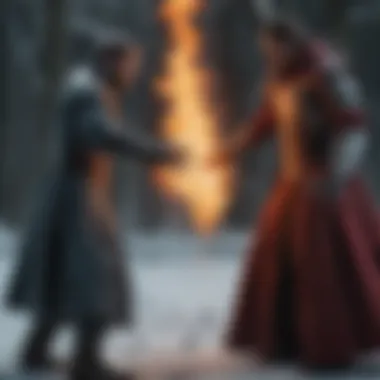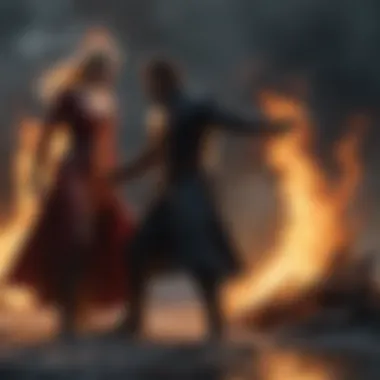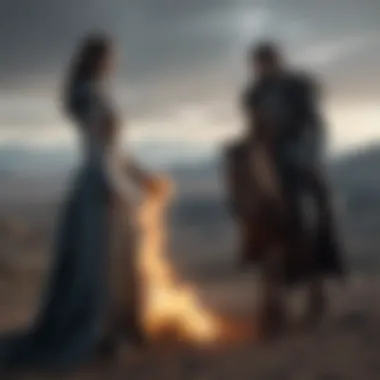Fire and Ice: Contrasts in Game of Thrones


Intro
In the world of Westeros, fire and ice are not merely elements; they embody the very essence of the struggle between opposing forces. This duality infuses Game of Thrones with a rich tapestry of conflict that transcends mere physical confrontations. The series showcases a spectrum of emotional and philosophical clashes that shape its characters and narratives.
Westeros thrives in a setting steeped in complexity where the stakes are high, and the choices made often lead to dire consequences. At its core, the thematic contrasts of fire and ice serve as metaphors for loyalty, ambition, and mortality, challenging characters to confront their true selves and the legacies they wish to leave behind.
So let us embark on this journey through the ironclad gates of Game of Thrones and delve deeper into the character dissection that reveals the groundwork of this elemental clash.
Foundations of Fire and Ice in Literature
In the grand tapestry of storytelling, the foundation upon which themes like fire and ice are built plays a crucial role. This duality serves as a powerful vehicle for conveying deeper emotional complexities and moral quandaries, resonating with readers on both conscious and subconscious levels. In the context of Game of Thrones, fire and ice are not just elements but stand as potent symbols of contrasting forces at play in the lives of the characters and the very fabric of Westeros.
Understanding these foundations is essential, as they provide insight into the motivations and actions of various characters. Moreover, the interplay between fire and ice often reflects larger themes of loyalty, ambition, and mortality. These elemental forces, while seemingly distinct, reveal the gray areas in human nature and the choices individuals must navigate in their quest for power and survival.
Literary Origins and Symbolism
From ancient literature to modern day narratives, the symbolism of fire and ice has long captivated storytellers and audiences alike. Fire is often associated with passion, destruction, and transformation. It burns fiercely, igniting change, yet its flames can also lead to devastation. On the other hand, ice symbolizes coldness, detachment, and a rigidity that can choke life out of its surroundings. The stark contrast between these elements creates a complex backdrop for the characters within Game of Thrones.
In George R.R. Martin's world, the characters embody these elemental traits:
- Daenerys Targaryen, with her dragons, embodies the fiery spirit of passion and rebirth, pushing against the barriers of her past.
- The Stark Family, steeped in honor and duty, mirrors the coldness of ice, steadfast but sometimes inflexible.
This dichotomy deepens the storytelling, enriching it with long-standing traditions within literature that echo through the ages.
The Influence of Mythology
Mythology often serves as a wellspring of inspiration for authors across genres. Fire and ice have their roots in various mythological tales, adding layers to their representation in Game of Thrones. In Norse mythology, for example, the world is created from the clash of fire and ice in a chaotic but fascinating balance. The realm of fire, Muspelheim, and the world of ice, Niflheim, are both necessary for creation, representing endless cycles of destruction and rebirth.
This mythological background presents an interesting lens through which to view characters like the Night King and Daenerys. The Night King can be seen as a chilling embodiment of ice—that which seeks to conquer and envelop; while Daenerys, the Mother of Dragons, stands for fire, a beacon of power and change. Their elemental clash is reminiscent of the ancient tales where gods and heroes waged wars to restore balance, a theme that resonates deeply within the saga.
"In the battle between the extremes of fire and ice, we find the essence of humanity's struggles and the dualities within our souls."
Thus, the literary origins and mythological influences contribute to a rich, complex narrative that goes beyond mere elemental forces; it dives into the psyche of humanity itself, exploring the depths and heights of our desires, fears, and morals.
Fire: The Element of Passion and Destruction
Fire represents a powerful dichotomy within the world of Game of Thrones. It embodies both the fervor of passion and the capability for untold destruction. This duality aligns perfectly with the turbulent narratives surrounding various characters, particularly those driven by ambition, love, and vengeance. Amidst the icy storms sweeping through Westeros, fire stands out as a catalyst for change, a force of rebirth and upheaval. Analyzing fire within this context allows us to unravel the complexities and motivations of key players in the series.
Daenerys Targaryen: The Mother of Dragons
Character Arc Overview
Daenerys Targaryen’s character arc is a profound exploration of her transformation from a frightened girl to a formidable ruler. One of the unique aspects of her journey is the real gradual embracing of her identity as the Mother of Dragons. Starting off as a pawn in her brother’s ambitions, Daenerys gradually evolves into a symbol of hope and destruction. Her initial innocence contrasts sharply with the fierce woman she becomes, creating a compelling narrative that showcases the dangers of unchecked power and ambition. Her complexities make her a vital subject for this article, as her fires of passion become a double-edged sword that reflects both her vulnerabilities and strengths.
Key Motivations and Decisions
Daenerys's motivations stem from a deep-seated desire for justice and reclamation of her family’s legacy. This drive compels her to exert force, often leading to significant moral dilemmas. Her decisions—like burning cities or freeing slaves—highlight her boldness but also paint her as a flawed leader. The unique feature of her motivations is how they resonate with the themes of justice versus vengeance, which are integral to her character. While her choices often empower her followers, they also instigate fear among adversaries, making her arc pivotal to understanding the implications of fire within the narrative.
Consequences of Her Choices


The consequences of Daenerys's actions ripple through the landscape of Westeros. Her fiery temperament often ignites conflict rather than alleviating it. Decisions like the incineration of King's Landing exemplify how her choices can lead to catastrophic outcomes, not just for her enemies but also for her allies. Such severe implications make her journey a classic representation of the balance between passion and destruction. As viewers, we see the toll of her fire-fueled decisions, and this dimension of her character poses questions about morality and leadership that fan the flames of discussion among audiences.
Melisandre: The Flame’s Tempest
Her Role in the Narrative
Melisandre serves as a significant agent of fire throughout the series. Her role in guiding key figures adds layers of intrigue and tension. As a priestess of R’hllor, Melisandre’s belief in the transformative power of fire frames her actions and choices. This unique feature of her character lies in her unwavering faith, painting her as a figure driven by a mystical understanding of fate and consequence. Melisandre’s presence illustrates the theme of fire as not merely a force of destruction, but a potential pathway to resurrection and ambition, pivotal to the broader narrative.
The Duality of Faith and Fanaticism
Melisandre stands at the crossroads of faith and fanaticism. Her fervent belief allows her to manipulate events to fit what she perceives as divine will. This duality reflects the contradictions in her character; while she advocates for the living with flames of passion, her decisions often evoke a sense of dread. In this regard, her reliability fluctuates, making her a controversial figure. The nature of this contradiction is significant because it emphasizes how fire can both illuminate paths to greatness and scorch them in the process. Her story compels us to ponder the line between faith and fanaticism, a theme that resonates profoundly with the series' overarching moral ambiguities.
Moral Ambiguity Explored
Melisandre’s moral ambiguity is a defining facet of her character, as it forces viewers to question the righteousness of her actions. Her use of dark magic, mixed with genuine beliefs, complicates her morality. This unique blend of traits allows her to not only be a catalyst for significant events, like the resurrection of Jon Snow, but also represents the unpredictable nature of fire. This character evokes discussion about the fine lines drawn in ethical dilemmas, challenging the viewers to consider what sacrifices are justified in the pursuit of a higher cause or destiny. In reflecting on her moral implications, we uncover deeper layers of conflict that engage with the themes of sacrifice and virtue within the story.
"Through fire, we find our greatest strength and threats, weaving a narrative that captivates the essence of Game of Thrones."
Ice: The Coldness of Detachment and Rigidity
In the realm of Game of Thrones, ice represents a formidable force characterized by emotional detachment, beyond mere weather conditions. It's not just a climate change; it's a reflection of the stark, unyielding nature of characters and their moral decisions. The duality of fire and ice in the narrative reveals how characters embody these extremes. The coldness of ice brings a meticulous examination of duty, honor, and rigid moral frameworks in Westernos. This element serves as a foil to the passion and heat of fire, allowing a detailed exploration of loyalty and the cost of integrity.
The Stark Family: Emblems of Honor
The Concept of Stark Honor
The concept of Stark honor is central to the ideology of the Stark family. Their unwavering commitment to principles shapes not only their fates but also the political landscape around them. Honor is seen as a guiding star, a measure of one's worth in the harsh reality of Westeros. Stark honor demands adherence to a code that often seems obsolete in a realm fraught with duplicity.
The rigidity of this code is both its strength and its weakness. It appeals to readers who value integrity and morality in a often morally grey world, represented by the noble Starks. However, such ideals can easily lead to tragic outcomes, as stubborn adherence to honor places them at odds with characters who thrive on manipulation and cunning.
Eddard Stark’s Downfall
Eddard Stark’s downfall serves as a harrowing embodiment of the consequences of unyielding honor in a treacherous environment. His steadfast commitment to truth and justice leads him directly to his demise. Eddard’s belief that loyalty and integrity would shield him from the deadly political games of King’s Landing exemplifies the tragic flaw seen in many noble characters.
Arguably, Eddard’s values resonate with the audience, representing a longing for simplicity in chaotic times. However, the unique feature of his fate is that it highlights the tragic cost of virtue. This dimension of Eddard's character underscores that sometimes, doing what is "right" in a morally grey landscape can lead to dire consequences.
Consequences of Their Morality
The consequences of the Stark family’s morality ripple throughout the series. Their adherence to honor invites not only death but also a sense of vulnerability that gets inherited by their children. Each member faces the burden of living up to the ideals that forged their family’s identity, often failing in the process.
What stands out about their morals is the stark reality that goodness is often at odds with survival in Westeros. This moral high ground, while relatable, presents significant disadvantages. Many characters exploit the Starks' inherent goodness, using it against them. This aspect becomes a platform for discussions on ethics, commitment, and the inherent flaws within unwavering morality.
The Night King: Emissary of Eternal Winter
Analysis of His Background
The Night King serves as a chilling antagonist, central to the theme of ice in the series. His origins delve into the depths of humanity’s fear of the unknown and the consequences of extremities. Born from betrayal and pain, the Night King's backstory raises questions about vengeance, loss, and detachment—a reflection of ice's relentless nature.
His character provides a dark contrast to the Stark family values. His existence emphasizes the horrors of emotional detachment. Exploring the background of the Night King enables a deeper appreciation of the choices made by characters living in the grip of his icy grasp, highlighting the consequences of their own emotional actions and neglect.


Impact on the Living Characters
The presence of the Night King creates an atmosphere of pervasive dread affecting all living characters throughout the series. His mere existence, combined with the threat he poses, forces characters into hard choices that challenge their established principles. The living must adapt or risk annihilation, blurring the lines drawn confidently by Stark honor.
Ultimately, his impact extends beyond physical confrontation; it reaches deep into psychological and emotional territories, where characters confront their fears and convictions. This ultimatum catalyzes both allies and foes to make crucial decisions, adding layers to the overarching narrative and character development.
The Symbolism of Fear and Death
The Night King's symbolism of fear and death intertwines with the elemental forces of ice. He embodies the existential dread that emerges from the cold, which reflects humanity’s struggle against the inevitable. Characters face their mortality in an unfathomable way, as the cold, emotionless ruin brought by the Night King leaves no room for negotiation or warmth.
Fear, encapsulated by the Night King, compels characters to question not just their actions but their very beliefs. This symbolism invites discussions on how the fear of death drives individuals to make choices that contradict their own moral compasses, ultimately revealing the agonizing struggles with detachment inherent to Westeros.
Ice symbolizes not just a character's exterior; it’s also a reflection of their inner turmoil and choices, shaping the world around them.
The Struggle Between Fire and Ice
The struggle between fire and ice in Game of Thrones serves as a pivotal thematic undercurrent that encapsulates the clashing forces of passion versus coldness, ambition versus morality, and loyalty against betrayal. This duality is not merely aesthetic; it profoundly shapes characters' motivations and decision-making. Readers are drawn into a world where these elemental forces mirror the emotional states of individuals and the broader conflicts within Westeros. Moreover, this struggle raises ongoing questions about the nature of humanity and the duality of existence, enhancing the narrative’s complexity.
Conflicts of Loyalty and Betrayal
Notable Betrayals in the Series
One cannot discuss the conflicts of loyalty and betrayal in Game of Thrones without addressing the myriad of betrayals that define the series. Notable instances, like the betrayal of Eddard Stark by Petyr Baelish, exemplify how personal loyalties can fracture, leading characters down dark paths. Betrayals often serve as catalysts for larger story arcs, thrusting characters into unforeseen conflicts and displaying the volatility of trust within power struggles. These betrayals convey an essential truth about the series: no bond is immune to the winds of ambition, emphasizing the precarious nature of alliances in a world ruled by fire and ice.
These betrayals are characteristic of the series; each decision to betray reveals something deeper about the motivations of the traitors and the impact on the betrayed. The unique feature of these betrayals is their ability to reshape the narrative landscape, propelling characters into pivotal roles while simultaneously determining their fates. The downside, however, is that sometimes these betrayals feel forced or contrived, straying from the characters' established arcs.
The Impact of Loyalties in Power Struggles
Loyalty is a two-edged sword in Game of Thrones, where allegiances often dictate not just survival but the ascendance or downfall of powerful houses. The unwavering loyalty of characters like Jon Snow highlights the significance of personal integrity in the fractured and harsh world they inhabit. However, these loyalties are tested time and again as characters confront dilemmas that pit their personal loyalties against the greater good, contributing to a rich tapestry of moral complexity.
The key characteristic of loyalties in power struggles is their fluidity. Characters constantly reassess their alliances based on shifting circumstances and personal revelations. This articulation of loyalty adds depth to the narrative, showcasing the often-painful choices characters must navigate. Yet, the constantly shifting loyalties can also leave viewers feeling disoriented, as previously loyal characters may suddenly turn on one another, complicating the audience’s emotional investment in them.
Thematic Representations in Key Events
The Battle of Winterfell
The Battle of Winterfell stands as a defining moment in the Game of Thrones saga, embodying the elemental clash of fire against ice. This confrontation illustrates the high stakes of the ongoing struggle, with characters on both sides representing their respective elemental affiliations. Daenerys, with her dragons, symbolizes fire, a force of destruction and creation, whereas the Night King's army embodies ice, representing death and inevitability.
While the battle is a spectacle of visual intensity, it also serves as a commentary on collaboration amidst chaos. The joint efforts of previously divided characters unite against a common enemy, highlighting themes of sacrifice and bravery. However, this event is not without its drawbacks. Some fans felt that the character arcs leading to this battle were rushed, diminishing the impact of the climactic showdown.
Significance of Fire and Ice in Their Clashes
The significance of fire and ice in their clashes extends beyond mere spectacle. These elemental forces symbolize the broader struggle between opposing ideals and philosophies within the series. Fire represents life, hope, and rebellion, while ice embodies despair, death, and the inevitability of fate. Each clash, particularly the major battles, encapsulates these themes, serving as a reminder that the war for survival is not just physical but also ideological.
The unique feature of these elemental clashes is the frequent ambiguity surrounding both sides. Characters and events often blur the line between right and wrong, forcing viewers to question their loyalties and beliefs. The overarching conflict of fire against ice encapsulates the essence of what Game of Thrones does best, making it a choice that resonates deeply with the audience while also weaving a complex cultural tapestry that critiques honor, loyalty, and survival.
Philosophical Implications of Elemental Forces
The elements of fire and ice in the Game of Thrones universe serve not just as aesthetic contrasts but also as powerful metaphors for deeper philosophical inquiries. These elements shape the narratives and motivations of key characters, revealing the underlying themes of morality, duty, and sacrifice that resonate throughout the series. Understanding these implications helps to enrich our appreciation of the characters’ journey and their moral complexities as they navigate the treacherous landscape of Westeros.


Exploring the Nature of Humanity
Conflict Between Personal Desire and Duty
One of the most striking aspects of Game of Thrones is the perpetual struggle between personal ambition and the responsibilities one bears to others. Characters often find themselves in heart-wrenching dilemmas where their own desires come up against their sense of duty to family, land, or even the realm itself. For instance, consider the plight of Jon Snow. He grapples with his heritage and his loyalty to the Night's Watch, a vow that demands his life and colors his choices throughout the series. This inner turmoil reveals how personal stakes can clash violently with societal expectations, making it an engaging topic for any analysis.
The key characteristic of this conflict lies in its universal relatability. Everyone has faced moments in life where choice is between personal happiness and obligation to loved ones. This element offers a rich avenue for philosophers and fans alike to dissect, positioning it as a crucial underpinning of character motivation. However, this conflict also has its drawbacks. Often, the resulting choices can lead to tragic outcomes, exemplifying how the weight of duty can sometimes be too much to bear.
The Role of Sacrifice
Sacrifice is intertwined with the themes of duty and desire, extending this philosophical exploration even further. Throughout the series, characters, including Eddard Stark and Daenerys Targaryen, face decisions that hinge on the notion of giving up something for the greater good or to uphold honor. Eddard’s fatal decision to uphold justice leads to convoluted consequences for himself and his family, illustrating that noble acts can bear bitter fruits.
This aspect of sacrifice speaks volumes about moral character. Characters who willingly give up their personal desires tend to garner sympathy from the audience, making their struggles poignant and relatable. Sacrifice illustrates the harsh reality in which noble intentions can lead to hardship, showcasing the dichotomy of hero versus martyr. The unique feature here is the inherent tension between nobility and pragmatism—noble sacrifices may not always yield the desired outcomes, often leaving behind a trail of pain and loss.
Ambiguity of Morality
The Grey Areas of Right and Wrong
In a world suffused with dread and conflict, Game of Thrones masterfully explores the ambivalence of morality. Characters find themselves navigating a morally grey landscape, where right and wrong are not easily discernible. The choices made by characters such as Jaime Lannister reflect not the absolute nature of morality but the contextual complexities that govern human behavior.
This ambiguity is a hallmark of the show, underlining that moral certitude is often elusive, making it incredibly engaging for the audience. While many viewers may root for particular characters, they often find themselves contending with the idea that good deeds can come cloaked in ill intentions and vice versa. This intricate portrayal of human behavior enhances the narrative depth of the series, allowing for extensive discussion and interpretation.
Character Analysis: Heroes vs. Villains
The heroes versus villains narrative has remained a staple of storytelling for centuries, yet Game of Thrones disrupts this traditional dichotomy, encouraging viewers to reevaluate their definitions of morality. Characters like Cersei Lannister embody villainy while often displaying traits that can be seen as relatable or understandable, creating sympathy where one might expect hatred.
By juxtaposing characters in this way, the series challenges the audience to ponder important philosophical questions. Are people born as heroes or villains, or are they shaped by circumstance? This aspect of character analysis reveals a nuanced portrayal of individuals whose actions defy simple categorizations, navigating through layers of choice and consequence. This enduring complexity provides ample fodder for discussion, propelling the narrative beyond mere entertainment towards richer philosophical engagement.
"It's not that I don't believe in the principles; it's that sometimes principles clash with the reality of survival."
Epilogue: The Dance of Fire and Ice
In wrapping up this article, it's essential to recognize the significance of the eternal struggle between fire and ice in Game of Thrones. This elemental clash reveals not just the dramatics of the series but digs much deeper into the emotional battles faced by its characters. Understanding this dance isn’t merely an exploration of fantasy elements but a doorway to dissecting the intricacies of humanity, ambition, and mortality.
The juxtaposition of fire and ice encapsulates the essence of two contrasting worlds – one driven by passion, ambition, and the thirst for power, while the other embodies cold detachment, honor, and inevitable doom. This dichotomy propels the narrative and shapes the fate of its characters, fostering a discourse about the moral implications underlying their choices.
Reflections on the Series’ Legacy
The legacy of Game of Thrones is woven intricately with the thematic significance of fire and ice. Viewers have come to appreciate how this dynamic framework defines not only individual characters but also entire arcs throughout the series. Characters like Daenerys and Jon Snow reveal profound truths about sacrifice, loyalty, and the heavy burden of destiny.
- Both elements contribute to the richness of character development, urging audiences to reflect on what drives human behavior. For instance, Daenerys’ fiery ambition leads to both triumphant victories and devastating consequences, embodying a dramatic reminder of the complexities of power.
- The Stark family's stoic adherence to honor serves as a critique of noble ideals in a world where survival often depends on choices made in desperation.
- The Night King, as a representation of ice, epitomizes the chilling consequences of a detached mindset—highlighting how emotional disconnection can lead not just to personal failure, but to existential threats faced by all.
As viewers look back on the series, the imagery of fire and ice persists not just in memory, but in the lessons imparted about human nature and moral conflict.
The Future of Westerosi Themes
Looking ahead, the themes of fire and ice promise to influence future narratives set in Westeros. HBO’s commitment to expanding the franchise through spin-offs presents opportunities to further delve into the elemental struggles that governed the original series.
- Anticipation is high for new tales that might explore the origins of these elemental forces, perhaps focusing on lesser-known houses or even the distant past of Westeros.
- Moreover, the philosophical musings surrounding fire and ice will undoubtedly continue to resonate as new characters and conflicts emerge. The allegorical aspects offer a fertile ground for storytelling, revealing the intricate balance between desire and responsibility.
As these themes evolve, they will likely deepen our understanding of what it means to grapple with personal desires against the stark realities of moral duty and existential risk. In the end, whether one identifies more with the flames of ambition or the frost of stoicism, the dance of fire and ice remains a powerful narrative lens through which to analyze not just the lore of Game of Thrones, but the very essence of humanity itself.
"The dance of fire and ice reminds us that in every conflict lies a deeper choice about who we are and who we wish to become."
Through all of this, we can only hope the future of Westerosi storytelling maintains the balance of these elemental forces, reflecting not just the battles within its pages but also the tumultuous journey of life itself.



